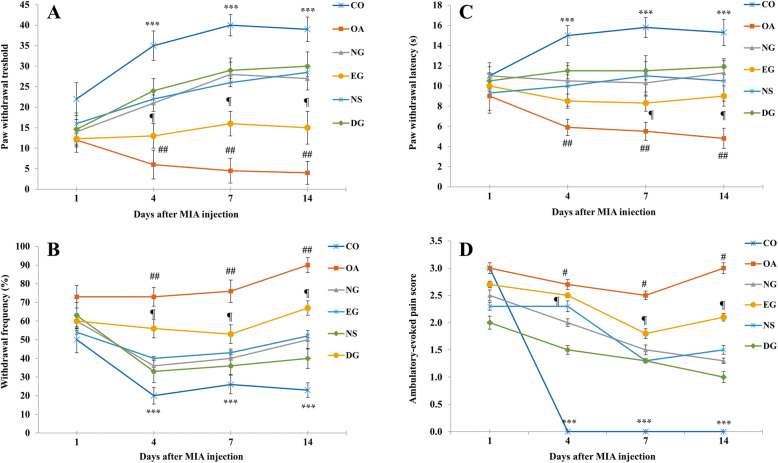Fig. 1.
The response to von-Frey filaments stimuli (paw withdrawal threshold; PWT) (a), acetone stimuli (paw withdrawals frequencies; PWF) (b), and noxious radiant heat (paw withdrawal latencies; PWL) (c) was measured at days 1, 4, 7, and 14 after the injection of MIA in all groups of the study (n = 6 in each group). PWT, PWF, and PWL were significantly decreased from the first day after MIA injection into the knee joint to the end of study. MIA injection caused a decrease in PWT, PWF, and PWL compared to the CO group. Also, the NG, EG, NS, and DG treatments significantly increased PWT, PWF, and PWL compared to the OA group on days 4, 7, and 14 after the injection. Also, the ambulatory-evoked pain was scored on days 1, 4, 7, and 14 for all animals (d). All the animals on the first day fell due to inflammation and pain caused by intra-articular injection. MIA injection caused a significant decrease in the limb use. All the treatments increased the limb use score in comparison to the OA group. The ambulatory-evoked pain was scored from 0 to 3 as follows: 0; no limp, 1; slight limp but no decrease in usage of the ipsilateral limp, 2; limp with decrease in usage of the ipsilateral limp, and 3; avoidance of usage the ipsilateral limp. Data are expressed as mean ± SEM. *** P < 0.001 compared to the CO group, ## P < 0.01 compared to the OA group, and ¶ P < 0.05 the NG vs. the EG group

